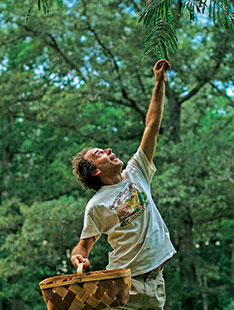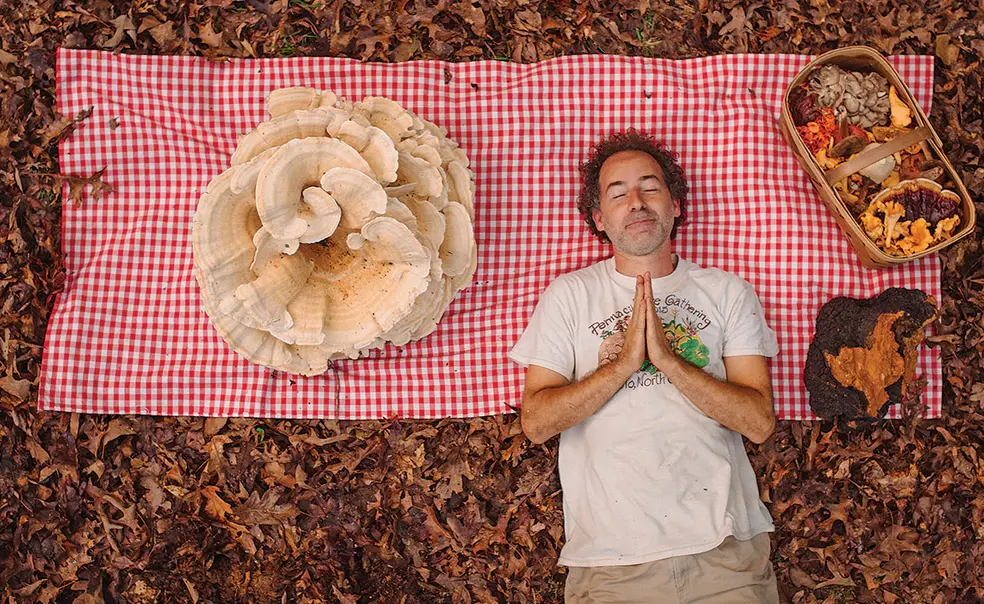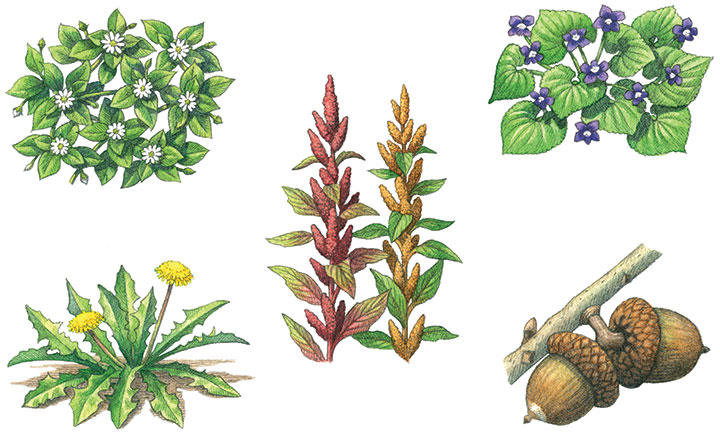Alan Muskat ’90: The Philosoforager
Ask Alan Muskat ’90 a yes-or-no question and he’ll make you define your terms first. Muskat, a philosophy major, is always searching for deeper meaning, looking for the essence of things. It’s befitting for this self-proclaimed philosoforager who instructs more than 1,000 people each year on the art of foraging for natural goodies.
In January, Muskat’s company, No Taste Like Home, led a meandering tour through 10 acres in the Blue Ridge Mountains just east of Asheville, N.C. He always forages with permission. There was fresh chickweed (salad green), white pine needles (tea), wild rosehips (jam and desserts), and 20 other wild foods. And that was in winter. A summer outing can produce armfuls of mushrooms, along with pawpaw, persimmon, sassafras, wineberry, and more than 100 other edibles.

Participants take their harvest to one of six Asheville restaurants, where a chef will transform it into a free appetizer, drink, or dessert. It’s something like Iron Chef meets Survivorman. Muskat calls it “find dining.”
Through Outdoor Action and the 2 Dickinson food co-op, Muskat, a Miami native, was introduced to hiking, cooking, and Taoism. His interest in natural living and his tendency to seek the essence of an experience led to foraging after college.
“I decided to drop out of the mainstream,” Muskat says. Unlike Thoreau in the 1840s, Muskat didn’t go entirely “into the wild,” but he did live on about $100 per month when he arrived in Asheville in 1995. When his savings ran out, he started selling his found harvest to restaurants and began teaching foraging classes.
Today, No Taste Like Home is the largest foraging-education organization in the country. With eight guides (and 10 in training), No Taste Like Home provides free and low-cost programs in public schools and operates 100-plus weekend tours during the busy summer season. Muskat is talking about training additional forager-educators in each state so the art will spread. He hopes that by 2030, every child in the United States will know the 10 most common wild foods in his or her area.
“The best foragers in the world are children. They are literally and figuratively closer to the earth,” reads one of Muskat’s many musings on the company’s website. “They notice what most adults overlook.”
Indeed, foraging takes the farm-to-table trend to new “lows” — as in ground level. Muskat sees the move as inevitable. “We have to get back to what’s truly natural. Even organic is neither local nor sustainable if you’re not growing what would otherwise thrive on its own.”
To some, he might sound too far outside the box. In the past five years, however, his company’s revenues have quadrupled. Muskat’s philosoforaging has drawn the attention of local-food luminaries, and he has raised more than a third of the $3 million needed to build a permaculture education center outside Asheville. Permaculture is sustainable, self-sufficient agriculture, much like foraging.
“Today most of us live in fear: fear of where our next paycheck will come from, fear of an increasingly chaotic world,” says Muskat. “To a hunter-gatherer, the world is not a battleground for limited resources.”
Five Common Wild Edibles
Wild edibles are abundant throughout the world. Many have superior nutritional qualities. It’s best to learn identification and qualities from an expert, says Alan Muskat ’90. Here’s a tiny sampling:
ACORN This nut of the oak tree is considered one of the oldest foods. Its flour can be used in cookies and more.
AMARANTH Tall with broad green leaves and bright red, purple, or gold flowers, amaranth is a highly valued ancient grain. It offers Muskat’s favorite greens; he considers the seeds a bonus. CHICKWEED A petite, spreading “weed,” it has tiny, white star-shaped flowers. It makes a delicious pesto.
DANDELION This common “pest” is identified by its toothy, deeply notched leaves when not bearing its unmistakable yellow flowers. The greens can be served in salad or sautéed with garlic.
VIOLET These native wildflowers have purple-blue, yellow, or white drooping blooms and heart-shaped leaves. The flowers are tasty in salad and are the flavor component of crème de violette liqueur.












4 Responses
Kari Kohl ’92
8 Years AgoNatural Edibles
While I admire Alan Muskat ’90 for his resourcefulness and his desire to experience the world around him (Princetonians, Sept. 13), his final quote in the article strikes me as quite silly and idealistic. While there is currently no “battleground for limited resources” among foragers, what does he think would happen if we stopped farming and ranching and everyone turned to foraging? Does he really think there is enough out there to sustain the enormous number of people we have living on this planet? I recommend he read Sapiens, by Yuval Noah Harari.
Christopher L. Webber ’53
8 Years AgoNatural Edibles
Re “Five Common Wild Edibles” (Princetonians, Sept. 13): All acorns are not alike, but the acorns from red and black oak, among the most common, have tannin levels that will prevent most people from having a good experience. Leach them thoroughly in boiling water and you have a chance, but not otherwise. And dandelion greens are best by far in the early spring. By the time they blossom, they will be too bitter to enjoy.
Lisa Radinovsky ’90
8 Years AgoForaging in Crete
It's fascinating to hear what my fellow 2D-er is doing these days! Reminds me, too, of the many foragers in Crete, Greece, where I've lived for 15 years. Since I don't trust myself to identify the many wild greens around here, I run into them while I'm gathering wildflowers in the olive groves.
Stella Metsovas
8 Years AgoChildren as Foragers
I love this quote! “The best foragers in the world are children.”